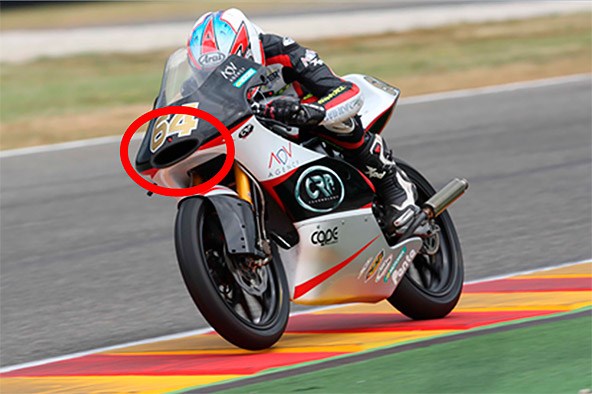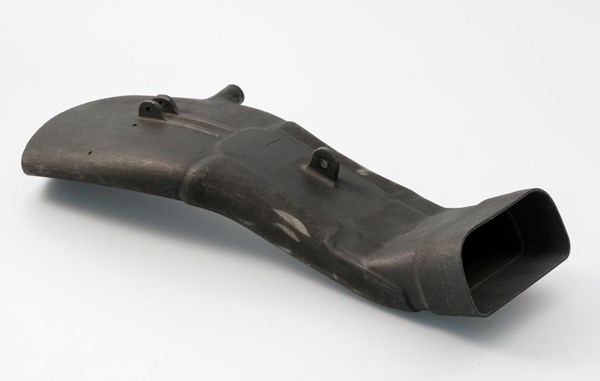New 3D-printed front air inlet made with Windform composite materials
CRP Technology recently developed a new front air inlet for a Moto3 racing customer, which was manufactured in Windform materials by using an SLS additive manufacturing technique.

Outlined in red, the front air inlet similar to the one produced in Windform. (Photo: CRP Technology)
Earlier this year, we reported that additive manufacturing provider CRP Technology (part of CRP Group Modena, Italy) had launched Windform RL, the first thermoplastic elastomer material within the Windform family of materials for professional 3D printing.
Now CRP’s R&D department said that it recently developed a new front air inlet for a Moto3 racing customer, which was manufactured in Windform materials by using an SLS additive manufacturing technique.
According to CRP Technology, testing had shown that increasing air flow to the air-box improved the performance of the engine at every RPM range. This led the team as well as the engineers to conclude that they need to design a new track ready inlet. This design would make the air inlet longer, and bring the opening up to the front side of the fairing, in order to have a direct air flow with less turbulence.
CRP wanted to avoid modifying the existing frame and the existing triple clamps. The design would have to fit to the existing platform in order to test the on-track advantages and disadvantages of using this solution, and to make a direct comparison with the current standard inlet.
The project
Once a first draft of the air inlet was developed, a prototype in Windform GF 2.0, which is a composite material with a polyamide base filled with glass and aluminum, was created. The decision to use Windform GF 2.0 was made to reduce costs, while being able to perform multiple tests with multiple prototypes.
The first prototype allowed engineers to see if the design fitment was correct and suitable for assembly. It was revealed by the first design that some sections needed to be changed due to the lack of space available under the lower triple clamp. This problem is further complicated when the bike is cornering and under braking conditions.
To optimize the volume of the inlet duct under the lower triple clamp, the engineers adopted a creative approach and decided to use a portion of the duct in Windform RL, the new rubber-like composite material produced by CRP Technology. This would be bonded to the main structure that was made out of Windform XT 2.0 for evaluation in racing conditions. To facilitate this, they also carried out a bonding test to study the characteristics of the final assembly.
The concept was to make the bottom part of the duct with Windform RL in the fork and triple clamp area, and then assemble this into the top part produced in Windform XT 2.0. This approach would allow good clear airflow on the straightaway sections of the course, and thus an excellent flow to the airbox. Under breaking, the front fender could move up and collapse the inlet duct without any damages, due to the flexible material.
The team and engineers eventually decided to change the inlet by reducing the portion that would make contact with the fender to reduce drag perceived by the rider. The part made in Windform RL was enlarged according to the second test, and engineers and the rest of the team could get the correct fit for performance.
In the final test version, Windform XT 2.0 was utilized in order to reduce the weight of the front and central part of the inlet, while the Windform RL material was used for the flexible part of the inlet. The two parts were bonded together after being produced.

Front air inlet (final version) after testing.
Related Content
Materials & Processes: Composites fibers and resins
Compared to legacy materials like steel, aluminum, iron and titanium, composites are still coming of age, and only just now are being better understood by design and manufacturing engineers. However, composites’ physical properties — combined with unbeatable light weight — make them undeniably attractive.
Read MoreJeep all-composite roof receivers achieve steel performance at low mass
Ultrashort carbon fiber/PPA replaces steel on rooftop brackets to hold Jeep soft tops, hardtops.
Read MorePrice, performance, protection: EV battery enclosures, Part 1
Composite technologies are growing in use as suppliers continue efforts to meet more demanding requirements for EV battery enclosures.
Read MoreMaterials & Processes: Resin matrices for composites
The matrix binds the fiber reinforcement, gives the composite component its shape and determines its surface quality. A composite matrix may be a polymer, ceramic, metal or carbon. Here’s a guide to selection.
Read MoreRead Next
CW’s 2024 Top Shops survey offers new approach to benchmarking
Respondents that complete the survey by April 30, 2024, have the chance to be recognized as an honoree.
Read MoreFrom the CW Archives: The tale of the thermoplastic cryotank
In 2006, guest columnist Bob Hartunian related the story of his efforts two decades prior, while at McDonnell Douglas, to develop a thermoplastic composite crytank for hydrogen storage. He learned a lot of lessons.
Read MoreComposites end markets: Energy (2024)
Composites are used widely in oil/gas, wind and other renewable energy applications. Despite market challenges, growth potential and innovation for composites continue.
Read More

















.jpg;maxWidth=300;quality=90)








